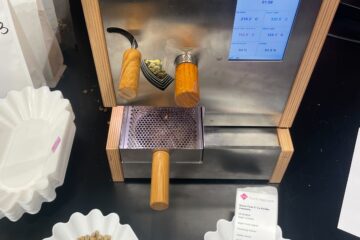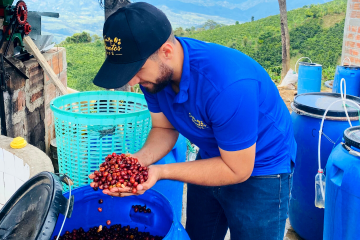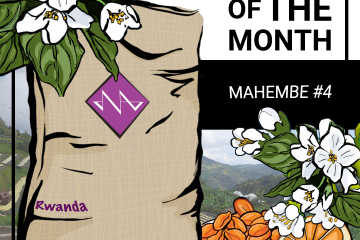We’re working on 4 main projects in 3 regions in Colombia this year – very exciting and lots to learn. Besides Finca Tamana, where we have been working for some years, we are working on projects with Coocentral in Central Huila, Cafe Sur in Tolima, and Buesaco in Nariño.
Everything is based on small farmers in areas with great flavor potential and high altitude. They all pick, process and dry their coffees on the farms before they deliver dry parchment to their Cooperative or Association. The only way to access a steady supply of great from Colombia is to find some Associations or Cooperatives with total trace ability and lot separation by farm, and to pay the growers good premiums when their coffees perform well on the cupping table.
Very often the good producers don’t get recognized as their coffees are blended, going in to the pile of that days delivery. They have been struggling for so long with low local market prices, not getting premiums for quality, and they really need a cash crop to survive. To invest in quality through fertilizer, selective picking and infrastructure at the farm they need good incentives. If they don’t see any good chances of receiving premiums they will not hold on to their parchment and can deliver what they have of small volumes weekly to get some cash to finance picking, production and the daily house hold needs.
Selective Cupping
Colombia can have some of the greatest coffees around, but at the same time you can find coffees from the same areas or groups that are over fermented or woody even before they leave the country. The way we now have chosen to work in Colombia is to find some groups with strong management in great areas and travel as much as possible to actively do as much cupping and selection based on flavor profiles as possible. By creating strong relations and figure out when the coffees are harvested and the local storage conditions, as well as supporting the programs from the Associations or Cooperatives, we believe we have an advantage in selecting the better coffees.
The way to achieve this is to be there at the right time post-harvest, cup a lot, and give the right incentives. As the coffees are individually produced by smallholders and due to the challenging weather conditions, the coffees can be inconsistent if you buy coffees without very thorough quality control and active lot separation based on cup profiles. In most cases we are cupping through loads of smaller parchment deliveries at origin before we decide what to keep as separate micro lots, typically 10 bags or less, and what to blend in to medium to bigger lots at 10 bags and up. Any larger lot sizes in areas like Huila, Tolima or Nariño, where there are mainly smallholders, will be a mix of coffees from a greater number of producers with small parchment deliveries. Randomly we can find pre blended lots from regional purchasing points that are cupping well, but we prefer to take the decisions ourselves.
Cafe Sur – Tolima
The Tolima project is in cooperation with a Cooperative called Cafe Sur. They have 5 main areas for purchasing in remote places in South of Tolima, It’s about 20 local bodegas (warehouses) that functions as purchasing points for the farmers in the Veredas (municipalities) around. They call the program Programa de Finca. Some of the purchasing points are close to the borders of both Cauca and Huila. In cooperation with us as importers and our exporter, they have initiated a program to incentivize and detect growers doing exceptional qualities. The deliveries per grower are relatively small and can vary from 300 kg of parchment up to 3000 kg of parchment throughout the season. I would guess the average per farmer now is around 700 kg. But most growers can deliver more when they see that the program works.
Cafe Sur have a very well functioning lab, cuppers and quality control system that ensures total trace ability. They also have protocols on processing and drying for the farmers that sign up for the program. I have just been there cupping through coffees from 60 growers. This was after the local cuppers there are doing their pre selection. We can then choose from which farmers we keep the lots separated by single producers, or blend some of them in to slightly larger batches after our scoring and the profiling. We are still re-cupping and confirm after the pre-screening in our lab as the roast and water quality was different when we were cupping there. We are paying premiums to the growers based on the scoring. Tolima have the main harvest around June, so all this coffees are really fresh harvested June/July. Unlike Huila, they are mainly having one harvest period per year. Coffees can be ready to ship in about 4 weeks from now, around the beginning of October.
Some notes from my cupping descriptions: Floral, complex, vanilla, sharp, structured, red currant, rosehip, balanced, solid, rich, dried fruits, candy, juicy.
Coocentral – Central Huila
Coocentral is doing a smallholder project in exclusive cooperation with NA to improve the quality of the coffee and livelihoods of the producers. Together with the Cooperative we came up with a list of criteria for elevation, varietals, processing and so on. Then Coocentral has actively gone out to farmers that fit with the concept, and are investing in follow up and training with the growers. There are about 70 farmers currently part of the project, and this can be increased – in total there are about 3500 members in the Cooperative.
They have purchasing points in Gigante, Garzon, Guadalupe, Suaza Tarqui, Pital, Agrado. The harvest in Central Huila is very spread out — some have the main harvest in May – July, and others from October – December. This means we will buy coffees 2 times a year from the project, and we also have priority and the first pick of these coffees. I cupped and purchased the first out turns from the first part of the harvest in June, and am now cupping the later pickings.
This project is a pretty unique thing for Huila, and we are partially using the Tamana model for picking, processing and drying. Coocentral is a very professional and strong Cooperative with very good people involved. They are actively following up the producers with technical engineers and agronomists. They also have funds for this specific project. There will be a mix of micro lots and medium sized lots based on cupping scores, profiles and lot sizes. The premiums are paid based on a scoring system, and the entire premium goes back to the growers.
We are occasionally also buying regional coffees that are not part of the program, but just good coffees received in the local warehouses. They pay higher prices on daily basis when the grower delivers impeccable parchment. They will still be trace able and from the members, but in this case the premium will be lower, and go entirely back to the cooperative that supports the members with social and technical benefits.
Some notes from my cupping descriptions: floral, mature red fruit, ripe mango, black berry, rich, black currant, orange, structured, creamy, juicy, intense.
Buesaco – Nariño
Nariño in general is one of the most challenging, but also interesting places to work. There is extremely high elevation, coffee up to 2200 meters, very steep hillsides, and mainly super tiny producers in remote areas. The flavor profiles are different from what we normally see in Huila and Tolima.
We are working with a Growers Association that are currently attracting a lot of great farmers as they have established a cupping lab, and through buyers like us pay the premium back to the growers. It’s a young organization and they got some funds to establish the cupping lab a year ago. They are in the town of Buesaco where there are plenty of similar private and Cooperative buyers, but none of them as far as I know are cupping and keeping the lots separated in the same way as these guys.
When a grower delivers his coffee it will be cupped immediately, and if it’s not up to standard they just resell it locally, to access the cash to buy and store good coffees only. They already now have a good number of top producers that are working with them on a consistent basis, and we have seen some truly amazing coffees. Some of the deliveries they are receiving can be down to 20 kg of parchment, and can potentially cup great. This will normally be blended with other coffees after cupping according to the profile. Still, they are also receiving coffees in volumes of 1000 kg of parchment per delivery. When they cup well they are always stored separately.
As the association doesn’t have any support by larger organizations like the cooperatives they have limited working capital. Through our exporter we are pre-financing them with working capital to secure our supply, and are that way also committing to buy from them. They are harvesting from May throughout July, and even some in August in the very highest altitudes. We bought some amounts in late June that are about to arrive now, and have just done our selection for the next shipment that will be shipped in about a month.
Some notes from my cupping descriptions: citric, floral, tea like, red berries, rhubarb, hibiscus, spicy and perfumy, complex, intense.
ETA
The first container has already arrived, and we expect the next containers of Colombians to land during October if all goes as planned. There will be more than 30 lots in total, and we are still doing cupping and selections.


